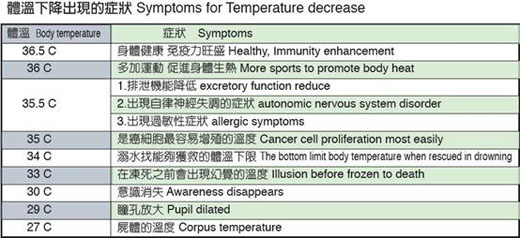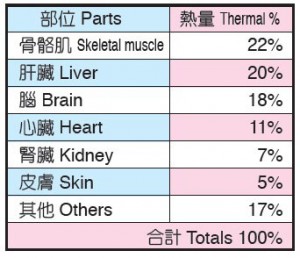
正常身體的溫度都維持在恆穩狀態,即36.50C。如果身體溫度超過37.50C,就會發生發燒及頭痛現象。身體會產生不舒服感。在這種情況下,我們比較容易察覺到。然而身體溫度若低於35.50C時,在醫學上稱為“失溫”,失溫的情形與發高燒同為身體有不正常的症狀所引起。不過它的發生而引起的危險情形,往往是在非清醒的時候(昏迷或睡眠中,尤其是後者)。所以比較容易被一般人所疏失或忽視。因此,“失溫”的程度不同,其影響於身體的情況也因此有所不同。平時只要注意天候環境的變化與自己的身體狀況,“失溫”的預防是比較可以事先防範的。
In a healthy body, the core temperature is consistently maintained around 36.5°C.
If the body temperature rises above 37.5°C, symptoms such as fever and headache occur, causing physical discomfort — which is relatively easy to notice.
However, if body temperature drops below 35.5°C, it is medically classified as hypothermia.
Like a high fever, hypothermia indicates an abnormal condition of the body.
The danger with hypothermia is that it often occurs during periods of unconsciousness (such as during coma or sleep, especially the latter), making it more likely to be overlooked or neglected.
The severity of hypothermia varies, and its impact on the body depends on the degree of temperature loss.
By paying attention to weather changes and one’s physical condition, hypothermia can largely be prevented.
| 年齡Age | 失溫Hypothermia | 產生病變狀況Related Physical Disorders |
| 40~50 | 1.5 | 腰酸背痛Lower back pain |
| 50~60 | 2.0 | 精神不振Mental fatigue |
| 60~70 | 2.5 | 頻尿Frequent urination |
| 70~80 | 3.0 | 生理機能退化、萎縮Physiological degeneration and atrophy |
| 80~ | 3.5 | 體臭(口臭)Body odor (including bad breath) |
表一 Table one
1. 根據世界醫學專家分析統計: 一般人失溫10 C是正常現象,但是年齡層越增長,“失溫”也就隨著年齡層增加,如(表一)。失溫超過3.50C就容易產生中風、栓塞。
Key Points:
1. According to global medical experts, a slight temperature drop of around 1.0°C is considered normal in aging.
However, the older the individual, the greater the temperature loss, as shown in Table One.
A hypothermia degree exceeding 3.5°C significantly increases the risk of stroke and vascular blockage.
2. 人體的冰箱效應。“失溫”就等於是“內涼”,失溫幾度就相對的產生外燥幾度(內涼=失溫);(內涼20C=外燥增加20C),因此老年人或重病者會失溫而造成內涼外燥。因此整晚翻來覆去,無法一覺到天亮。因而產生腰酸背痛及其他病症的主要原因。
2. The Refrigerator Effect of the Human Body:
Hypothermia can be described as internal cooling (internal cold).
For every 2°C decrease internally, the body’s external dryness increases by 2°C.
Thus, elderly individuals or severely ill patients often experience “internal cold and external dryness,”
leading to restless nights, frequent tossing and turning, and health problems like lower back pain.
3. 在醫院急診室手術房痲醉時是跟睡覺同屬失溫現象(麻醉=睡覺,失血=失溫),所以做痲醉準備手術的病患,都要有紅外線保溫燈來保住人體的溫度。
3. In hospital emergency rooms and operating rooms, anesthesia induces a state similar to sleep, and both lead to hypothermia (anesthesia = sleep; blood loss = hypothermia).Therefore, patients under anesthesia are typically provided with infrared warming lamps to maintain body temperature.
4. 一般病患及動手術後復健中的病患,“失溫”狀況會比正常人多10C以上。婦女或生產中((坐月子)也比正常人失溫多10C以上。
4. Post-operative and rehabilitating patients often experience a body temperature drop of over 1.0°C compared to healthy individuals.
Women in postpartum confinement (during “sitting the month”) also experience a temperature drop of more than 1.0°C.
5. 世界醫療學者,專家,經研究報告,一般人於40歲就會開始產生人體失溫現象,至50歲開始產生病變,60歲就會散發體臭,頻尿,生機能退化。隨著年齡增長越嚴重, 這主要原因跟人體“失溫”有關。
5. Research reports from international medical scholars show that hypothermia begins around age 40, leading to physical disorders starting at around age 50.
By age 60, symptoms such as body odor, frequent urination, and decline in physiological functions become apparent, worsening with age —
with hypothermia being a primary cause.
6. 人體血液要循環,人體氣色要順暢,人體尿液要通暢,就必須要多運動,多喝水,多排尿。因此人體溫度是最重要不可或缺的,人體失溫會隨著年齡層增長而增加,所以年紀愈大的人就越怕冷。
6. For healthy blood circulation, good complexion, and smooth urination, it is essential to engage in regular exercise, drink plenty of water, and urinate frequently.
Thus, maintaining an optimal body temperature is vital and irreplaceable.
Since body temperature loss increases with age, older individuals become more sensitive to cold.

失溫會造成人體 : 老化、退化、萎縮等病變
Hypothermia Leads to Aging, Degeneration, and Atrophy in the Human Body
1. 一般老年人到了夏天熱得發昏又不敢吹冷氣,怕這邊酸,那邊痛,而且整晚睡不著覺,翻來覆去,背部溫度高,腳部卻冰冷。這種內涼外燥的現象都是跟體溫調節有關。
1. In summer, many elderly individuals feel faint from the heat yet avoid using air conditioning out of fear of aches and pains. As a result, they often experience sleepless nights, tossing and turning, with high temperatures in the back while their feet remain cold.
This internal cold and external dryness phenomenon is closely related to impaired body temperature regulation.
2. 根據醫學專家統計,人到 40歲以上,就有可能晚上會起來排尿一次, 50 ~ 60歲以上有可能排尿丹,也就是隨著年齡增加越會有頻尿的現象。這就是人體的體溫調節功能失常所導致的。
2. According to medical experts, after the age of 40, it becomes common to wake up once at night to urinate.
Between 50 and 60 years old, the frequency of nighttime urination tends to increase with age.
This is a sign of dysfunction in the body’s temperature regulation system.
3. 多頻譜生物熱能理療床墊,針對人體有調節體溫功能,能提升睡眠品質,讓您一覺到天亮,甚至睡覺前皆可放心喝杯水。
3. The Multi-Spectrum Biological Thermal Therapy Mattress is designed to assist in regulating body temperature, improve sleep quality, and allow users to sleep through the night comfortably — even enabling them to drink a cup of water before bedtime without worry.
4. 每個人的體質不同,可隨著個人的體質調整到你感覺舒適的溫度。使用後早上起床會有點口乾舌燥的感覺,這是正常的現象。
4. Since each person’s constitution is different, the mattress temperature can be adjusted to a comfortable level for each individual.
It is normal to experience slight dry mouth upon waking, indicating the body’s natural thermal adjustment.
5. 如果在年輕時就能夠盡早做好體溫調節,對身體生機能的保健有更進一步的認知,這對身體健康,精神飽滿是有非常大的幫助的。尤其是還有很多人必須靠調適體溫來維持正常溫度。如開刀動手術的病人,產婦,缺乏活動,經常臥病在床不能行動者,及預防褥瘡者等,都不該忽略體溫的變化,更應該做好人工調節體溫的需要。
5. If body temperature regulation is maintained properly from a young age, it can significantly contribute to overall health, vitality, and mental alertness.
This is especially important for individuals who rely heavily on artificial temperature regulation, such as surgical patients, women in postpartum recovery, those with limited mobility, bedridden patients, and individuals seeking to prevent pressure ulcers.
They must pay close attention to maintaining proper body temperature.
6. 如何調節體溫已成為當今人類追求健康,長壽,養生,而能享受舒適生活的時代所要求,也是人人不可不知的養身,保健的議題。尤其冬天睡覺的時候,由於身體中許多機能的停頓,特別是年老的人失溫幅度更大。中風、栓塞事故明顯增多。因此更應該突顯出保持正常體溫的重要性。
6. Learning to regulate body temperature has become an essential topic in the modern pursuit of health, longevity, and well-being.
This is particularly important during winter, when body functions slow down and elderly individuals are more prone to severe hypothermia, resulting in a significant increase in stroke and vascular blockage incidents.
Thus, the importance of maintaining a normal body temperature cannot be overstated.
使身體失溫的『六大因素』
1.運動不足
2.長期在冷氣環境下工作、睡覺
3.精神與工作上過於緊張、壓力大
4.錯誤的洗澡方式
5.錯誤的飲食(如冷飲料、冷食物)
6.服用過多的化學藥品
Six Major Causes of Hypothermia
1. Lack of exercise
2. Prolonged exposure to air-conditioned environments during work or sleep
3. Excessive mental stress and work pressure
4. Incorrect bathing habits
5. Improper diet (e.g., consumption of cold foods and beverages)
6. Overuse of chemical medications

身體失溫是各種疾病的起因。因此從這方面來看,我們現代人每天必須測量的不是體重,而應該是體溫。
因為心臟全天 4小時都不眠不休地運作著,是人體發出熱量相當大的器官。心臟的重量只佔體重的0.5%,所產生的體熱卻佔全身的11%。脾臟是位於上腹部,胃下左後方,約有100公克重量,是負責製造淋巴球、單核球(巨噬細胞)等白血球,最大的特徵是貯藏著紅血球。溫度很高。換言之,心臟和脾臟是體內溫度最高的部位,所以不可能產生癌症。相反的,容易罹患癌症的器官有胃、大腸、食道、子宮、卵巢、肺等管狀器官。因為整個臟器只有四周有細胞,裡面是中空的,所以溫度不高,再加上與外界相通,溫度更容易下降,所以罹患癌症的機會就更高。
Hypothermia is a root cause of various diseases.
From this perspective, modern people should focus on measuring body temperature daily rather than body weight.
The heart operates continuously 24 hours a day, producing a substantial amount of body heat.
Although the heart only accounts for 0.5% of total body weight, it is responsible for generating 11% of the body’s total heat.
The spleen, located in the upper abdomen behind the stomach on the left side, weighs about 100 grams.
It produces lymphocytes and monocytes (macrophages), stores red blood cells, and maintains a relatively high internal temperature.
In other words, the heart and spleen are the warmest organs in the body, and thus cancer rarely occurs in these organs.
In contrast, organs prone to cancer include the stomach, colon, esophagus, uterus, ovaries, and lungs — tubular organs that have cell linings only on their outer surfaces and are hollow inside.
Their lower temperatures and exposure to the external environment make them more susceptible to cancer.
此外,乳房也很容易罹患癌症,或許是因為乳房突出於體外,溫度容易變低。而且,我們已知乳房愈大的人就愈容易罹患癌症,因為不論乳房的大小,輸送營養和氧氣到乳房的動脈數量都是一樣的,既然血液的供給量相同,乳房愈大就愈容易變冷。
Similarly, breast tissue is highly prone to cancer, likely because it protrudes outward from the body, making it more susceptible to cooling.
Studies have shown that the larger the breast size, the higher the risk of breast cancer, because the number of arteries supplying nutrients and oxygen remains the same regardless of breast size.
Thus, larger breasts have relatively poorer blood circulation, leading to lower temperatures and increased cancer risk.

